A beautiful tropical plant, bougainvillea boasts clusters of papery flowers ranging from hot pink to magenta, fiery orange to deep purple, as well as red and white. Add a touch of tropical magic to your garden with a few bougainvillea plants cascading down walls, spilling over trellises, or flourishing in pots. Of course, to keep it in top shape, you need to find the best fertilizer for bougainvillea.
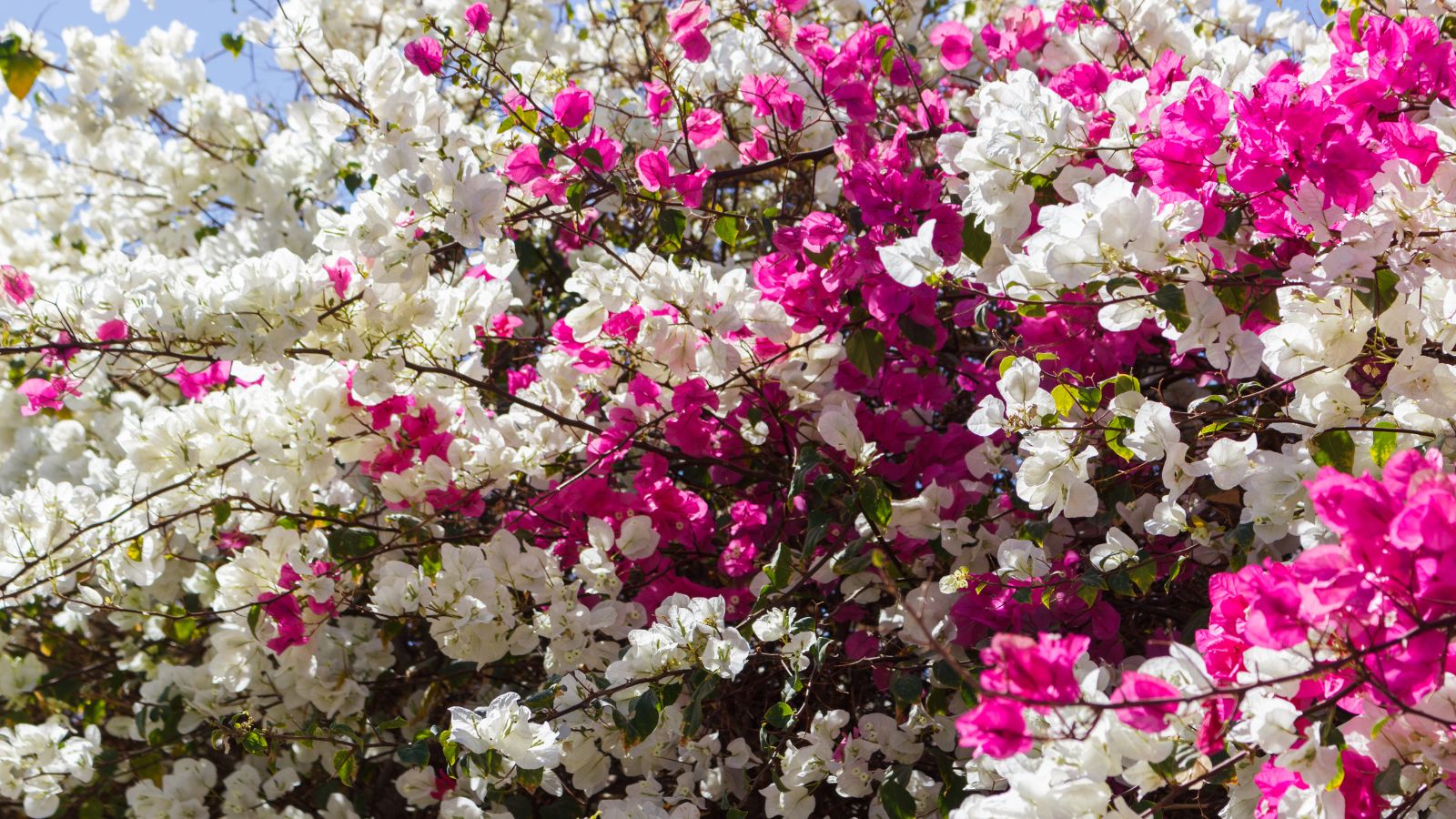
An interesting fact about bougainvilleas is that the colorful part of the plant is not the flower but modified leaves (or “bracts”) that protect the flowers inside. Regardless, when you think of bougainvillea flowers, you think of the colorful bracts that provide a striking contrast to the dark green leaves and thorns.
Today we’ll look at how to care for a bougainvillea, including the best fertilizer, how to use it, and what each component in a fertilizer does for a bougainvillea. This is a complete guide about caring for and maintaining a healthy and colorful bougainvillea.
What is the Best Fertilizer for Bougainvillea?
Bougainvilleas require a balance of nitrogen, phosphorus, and potassium. They also prefer a slow-release fertilizer. Furthermore, bougainvilleas thrive in hot, dry climates and loose sandy soil. Fertilize your bougainvillea every month during the growing season for striking and colorful flowers.
Nitrogen, phosphorus, and potassium are the three macro-nutrients that all plants need to survive. Nitrogen takes care of the plant’s foliage. Therefore, nitrogen is essential if you want your bougainvillea to produce lush green foliage and bright and plentiful flowers.
Phosphorus takes care of the bougainvillea’s roots and stems. The health of a plant’s root system is critical, as it ensures that the plant can absorb water and nutrients from the ground. Finally, potassium, also known as potash, ensures the general health of the entire plant. Potassium helps prevent your bougainvillea from getting diseases or suffering overly from pests.
When you buy a fertilizer, the amount of nitrogen, phosphorus, and potassium in the fertilizer is indicated by the values N:P:K on the label. N represents nitrogen, P represents phosphorus, and K represents potassium. Bougainvillea requires equal amounts of nitrogen, phosphorus, and potassium. Therefore, you should opt for a fertilizer with an NPK ratio of 4:4:4 or 10:10:10.
In addition to the NPK ratio, you must decide if you want to use organic or chemical fertilizer. There is also a choice between quick-release or slow-release fertilizers. You should know the difference between these fertilizers to ensure you buy the right kind for your bougainvillea.
Organic vs. Chemical Fertilizers for Bougainvillea
You’ll notice that countless fertilizers are on the market, all claiming to be the best. Not all of these fertilizers are the same; one difference between them is organic vs. chemical ingredients. These two types of fertilizers differ in terms of their composition and effect.
Chemical fertilizers are often more concentrated than organic fertilizers. Therefore, you can use less chemical fertilizer on a bougainvillea. However, chemical fertilizers don’t add any nutrients to the soil itself and often cause salt buildup in the soil.
We recommend switching between different brands to limit the salt buildup when using chemical fertilizer. Also, use chemical fertilizer sparingly, as it may burn the stems and roots of your bougainvillea.
Organic fertilizers contain natural materials that help replace the minerals and nutrients lost in the soil. They also aren’t as concentrated or toxic as chemical fertilizers. Therefore, we recommend opting for an organic fertilizer if possible. If you use chemical fertilizer, add some organic matter, such as compost or bone meal, to the soil.
Quick-Release vs. Slow-Release Fertilizer for Bougainvillea
Another choice you have when deciding on fertilizer is between quick-release and slow-release options. Quick-release fertilizers often come in liquid form. They are less concentrated and are absorbed by the bougainvillea’s roots soon after being applied to the soil. You must apply quick-release fertilizers more often than slow-release ones.
Slow-release fertilizers are often more concentrated. They come in a solid pellet form that starts to break down when you wet the soil. The fertilizer is then absorbed by the soil and later by the bougainvillea’s roots.
The choice is yours when deciding which kind of fertilizer you would like to use. However, as bougainvilleas seem to do better with a slow-release fertilizer, we recommend using a slow-release fertilizer for your bougainvillea. Pellets work well and are easy to apply. Plus, you only have to apply a slow-release fertilizer once in a while for your bougainvillea to flourish.
The Best Fertilizer Brands for Bougainvillea
You now know the difference between organic and chemical fertilizers and quick-release and slow-release fertilizers. However, you might still be confused about the best fertilizer brands for bougainvillea. We recommend fertilizers specifically formulated for exotic plants or bougainvillea, with equal amounts of nitrogen, phosphorus, and potassium.
Regular all-purpose fertilizers may also work. However, they will likely cause your bougainvillea to produce an excess of lush green foliage and very few flowers. The best fertilizers for bougainvillea are:
These fertilizers contain equal or almost equal amounts of nitrogen, phosphorus, and potassium. In addition, they are all slow-release fertilizers, making them perfect for bougainvillea plants. With these or similar fertilizers, you should have a thriving bougainvillea full of flowers in the summer.
The final question is when to fertilize a bougainvillea plant for the best results.
When to Fertilize a Bougainvillea
Since bougainvilleas are heavy feeders, it’s recommended to apply a slow-release fertilizer around your bougainvillea’s roots every thirty days during its growing season (early spring to midsummer). Don’t apply fertilizer when your bougainvillea is in its dormant phase, because the plant is cold-sensitive, and new growth will be damaged.
Your fertilizer’s packaging will indicate how much fertilizer to use. In addition to applying the fertilizer, you can also add other organic components, such as compost, bone meal, or alfalfa meal, to the soil.
Water the soil thoroughly after applying fertilizer. If you notice that your bougainvillea looks a little under the weather, add a bit more fertilizer to the soil. However, if you notice the stems or leaves yellowing after applying fertilizer, the fertilizer is too strong, burning your plant. In this case, use less fertilizer or switch to another brand.
Bougainvillea plants prefer a fertilizer with equal parts nitrogen, phosphorus, and potassium. They also grow best with a slow-release fertilizer and a warm, dry climate. Add fertilizer to the soil every thirty days during the growing period. An organic fertilizer will help replace some of the nutrients the soil loses.
Need Some Inspiration? Check Out These Bougainvillea Pictures
Not familiar with bougainvilleas and want to learn more? They love full sun and well-draining soil, so make sure you plant them where they can have at least 6 hours of direct sunlight daily and there’s no risk of too much water or damp soil.
Did you know that there are over 300 bougainvillea varieties? Here are just a few:
- Bougainvillea glabra
- Bougainvillea spectabilis
- Bougainvillea peruviana
- Bougainvillea brasiliensis
- Bougainvillea buttiana
- Bougainvillea ‘Barbara Karst’
- Bougainvillea ‘Singapore Pink’
- Bougainvillea ‘California Gold’
- Bougainvillea ‘Juanita Hatten’
- Bougainvillea ‘Imperial Delight’
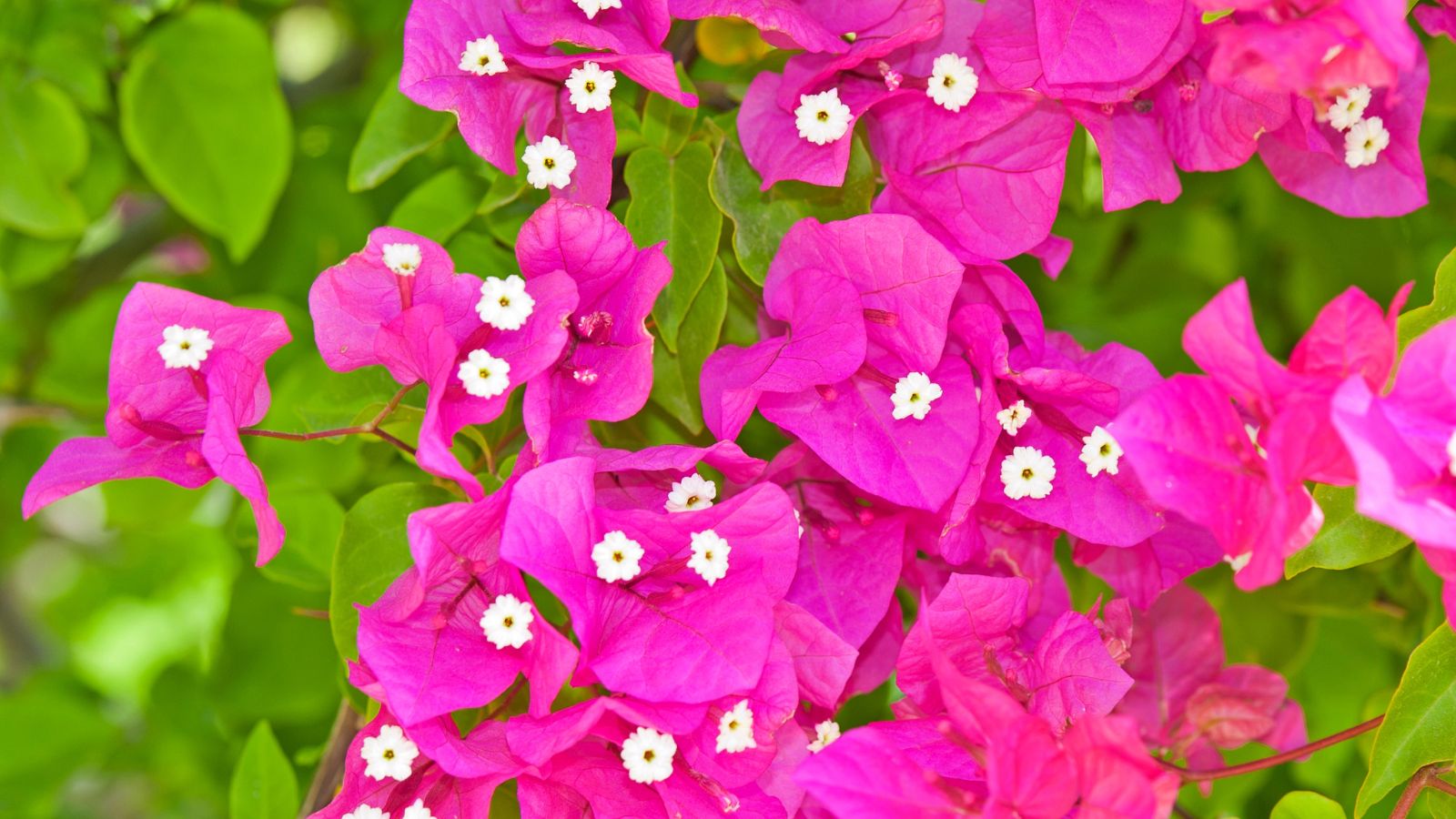
What a gorgeous closeup of pink bougainvillea blooms! I love them so much!

I like how the mixture of yellow, orange and purple bougainvilleas in this flower border. They make a nice contrast and add color to the fresh green of the leaves.

These pure white flowers would make a stunning background for some red roses, pink peonies, or deep blue iris.
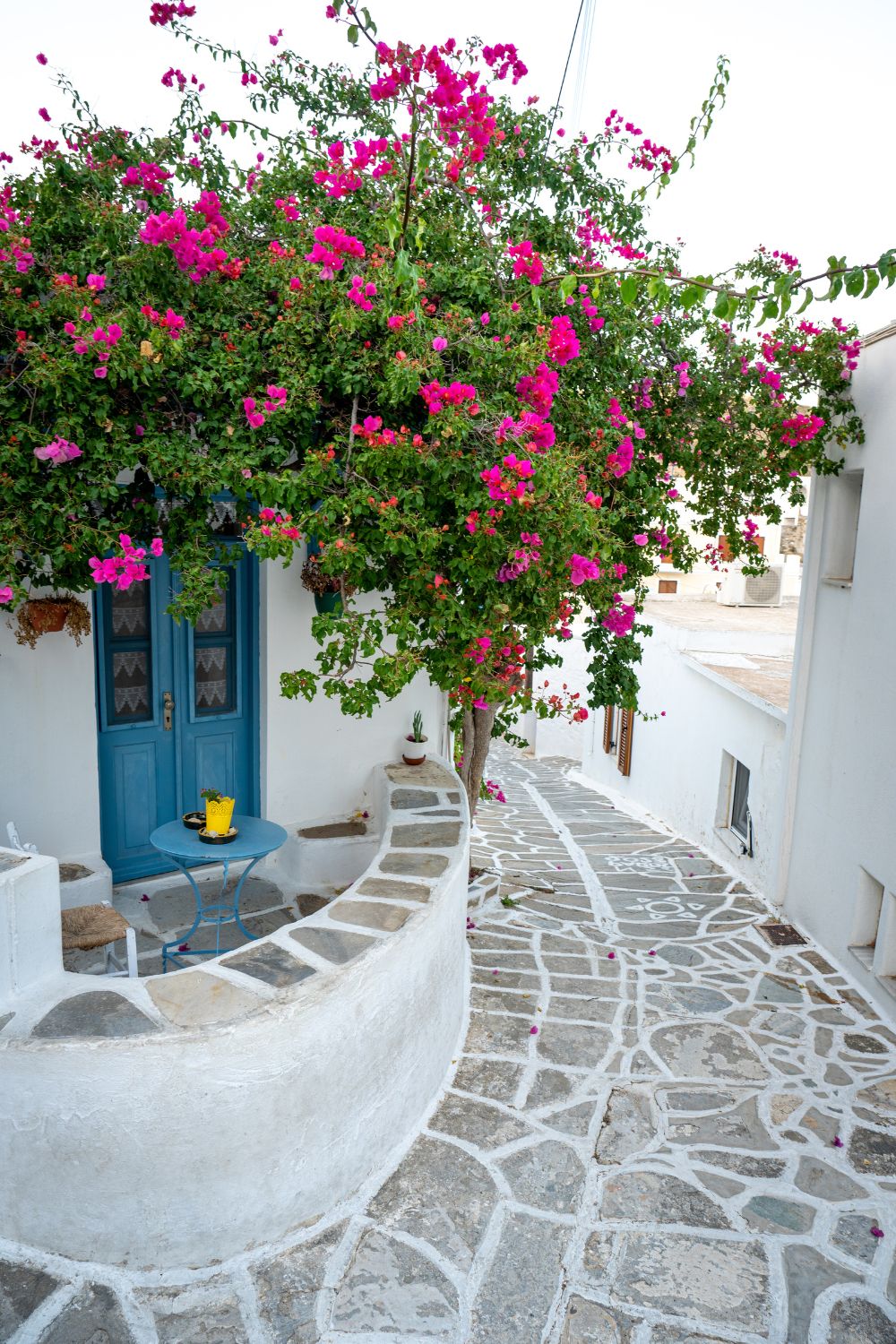
I can only imagine one of these bright pink arches greeting me daily as I come home. What a stunning home entrance!
If you don’t have a lot of room for a full-size in-ground plant, there are a few dwarf varieties you can grow in small containers. Just make sure your container has good drainage (you need drainage holes) and use rich soil to get a healthy bougainvillea.
Adding a good fertilizer every 30 days during the blooming period or so is the best way to keep it blooming beautifully. Regular pruning help too, and since bougainvillea grows on new wood, you don’t have to worry that you pruned the wrong branch,
Hopefully, now you’re better prepared to grow beautiful bougainvillea flowers in your own yard. Go plant some and have fun watching them grow.
Need more ideas for flowers that thrive in the sun?
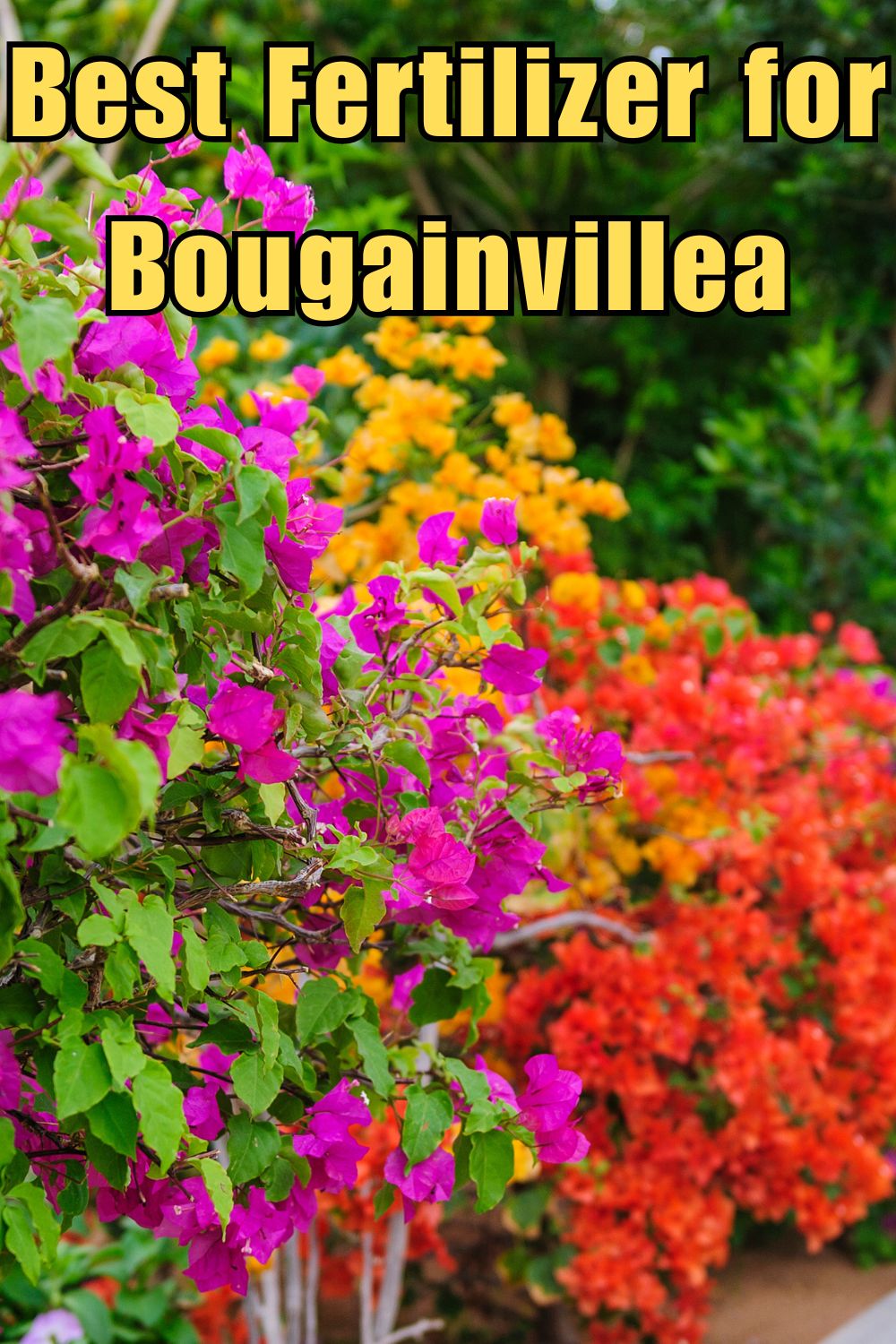

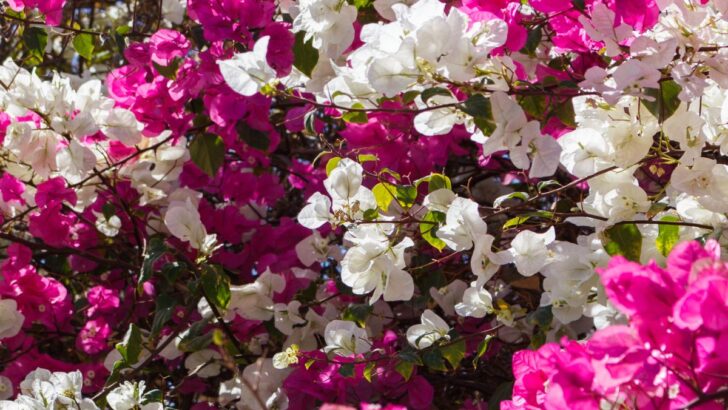



Pink Flowering Shrubs For Any Garden
Friday 21st of April 2023
[…] pink shrubs! Here’s a pink bougainvillea draping over a brick wall. Beautiful! Find out what the best fertilizer for bougainvillea […]
6 Fun Ideas For Landscaping Around Water Fountains
Friday 21st of April 2023
[…] A fountain statue in front of an arbor of climbing roses, clematis, or bougainvillea (check out how to fertilize bougainvillea), if you have enough sun, may look great in a formal garden. But if you want to maintain a wild, […]